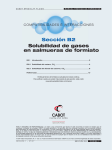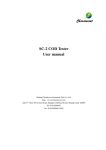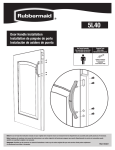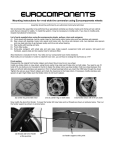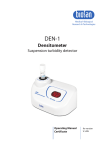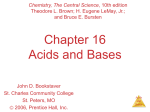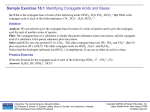Download "user manual"
Transcript
CHEM 206 section 01 LECTURE #25 Wed. April 9, 2008 LECTURE TOPICS: TODAY’S CLASS: 18.1-18.2 NEXT CLASS: finish Ch.18 (up to 18.5) (1) 18.1 The Common Ion Effect Ö basis of all Ch.18 = shift in eqm position that occurs because of addition of an ion already involved in the equilibrium of interest (cf Le Châtelier…) Ö rxn initially speeds up in direction involving that ion… AgCl(s) Ag+(aq) + Cl-(aq) Adding HCl(aq) to a sat’d solution of AgCl causes some AgCl to precipitate out CH3COOH(aq) + H2O(l) CH3COO-(aq) + H3O+(aq) Adding CH3COONa to a solution of acetic acid “inhibits” the acid’s dissociation (2) Same effect: Add another source of H3O+ (e.g., HCl…) 18.2 Buffer solutions resist changes in pH… Compare how pH changes when add 5 mL of dilute HCl (0.01 M) Both beakers contain alizarin = indicator that is pink at neutral pH but yellow in acidic solution Use pH meter: monitor pH Ö verify cause of indicator’s response Fig.18.2: Buffer vs. pure water: WATER BUFFER now at appears pH 2.3 ~ same WATER BUFFER at pH 5 of pH 7 (3) How? Before adding dilute acid After adding dilute acid Water itself cannot resist changes in pH H2O(l) + H2O(l) Initial OH-(aq) + H3O+(aq) 10-7 M If add a strong base Ö increase [OH-] Ö tiny [H3O+] to shift left with Ö large [OH-] remains… Ö pH ↑↑↑ (4) Kw = 10-14 10-7 M If add a strong acid Ö increase [H3O+] Ö tiny [OH-] to shift left with Ö large [H3O+] remains… Ö pH ↓↓↓ How does a buffer resist changes in pH? A BUFFER = solution containing a mixture of a weak acid/base & its salt i.e., a weak acid-base conjugate pair together in solution! Weak acid HA = proton donor Ö consumes added base Conjugate base A- = “proton sink” Ö consumes added acid Solution’s pH only changes significantly if HA or A- runs out… CH3COOH(aq) + H2O(l) HA A- add acid “ H3 O+ Slight shift to more acidic pH • eqm shifted left… • some A- consumed • not all of added H3O+ used (5) ” CH3COO-(aq) + H3O+(aq) HA A- 1:1 [HA]:[A-] starting with pH = pKaHA add base “ OH- HA ” A- Slight shift to more basic pH • eqm shifted right… • some HA consumed • not all H3O+ replaced Understanding buffers: AN EFFECTIVE BUFFER HAS… 1. Roughly 1:1 ratio of weak conjugate A/B pair HA & ABH+ & B: Want ability to react with random additions of acid or base [HA]:[A-] from 10:1 → 1:10 works very well Implication: a buffer will maintain a pH close to HA’s pKa… pKa ± 1-2 pH units 2. Relatively large concentrations of both HA & A- So that do not run out of either HA or A Usually see concentrations in 10-2 → 1 M range Provides high buffer capacity to counteract added acid/base = amount of strong HA or B needed to change pH of 1L by 1 unit 3. No reactivity/toxicity towards substances/organisms you are trying to study! (6) Ex.1: What is the pH of this buffer? (the long way…) Imagine you prepare a buffer by adding 0.125 mol of ammonium chloride to 500.mL of 0.500M aqueous ammonia (NH4+ Ka = 5.6x10-10). NH4+(aq) Initial Change Eqm Ka = 0.250 M Ka + H2O(l) built into Ka - x --- 0.250-x --- [NH3][H3O+] [NH4+] NH3(aq) + H3O+(aq) 0.500 M + x 0.500+x 5.6x10-10 = 0 + x + x (0.500+x)x 0.250-x K << 1000x smaller than BOTH large initial [ ]’s Ö double approximation (top & bottom!) pH = -log[H3O+] = -log(1.18x10-5)] = 9.55 (2SF) So: 5.6x10-10 ≈ Adding H3O+ or OHwill change pH only very SLIGHTLY… (7) 0.500x 0.250 x = (0.250 x 5.6x10-10)/0.500 x = 2.80x10-10 M = [H3O+] Estimating the pH of a BUFFER: the Henderson-Hasselbalch Eq’n A-(aq) + H3O+(aq) IF SOLUTION CONTAINS: HA(aq) + H2O(l) double approx’n Ka ≈ [A-]0 [H3 O+] 1) Weak acid & conj.base 2) High concentrations 3) [HA] ≈ [A-] eq [HA]0 THEN: it is a buffer double approx’n works [H3O+] ≈ Ka [HA]0 [A-]0 -log[H3O+] ≈ -logKa + -log[HA]0 [A-]0 Flip quotient to reverse log’s sign Henderson-Hasselbalch Eq’n pH = pKa + log [A-]0 [HA]0 User’s manual for Henderson-Hasselbalch equation: HOW: use initial [A-]:[HA] ratio (= double approximation) WHEN: if [A-]o:[HA]o= 10:1 → 1:10… (but not outside this range) NOTE: do NOT use for other solutions (must be ~1:1 weak conj. pair…) (8) Ex.2: How much does our buffer’s pH change if…? Same buffer as before: 0.125 mol of ammonium chloride in 500.mL of 0.500M aqueous ammonia (NH4+ Ka 5.6x10-10). (a) Estimate the pH of this buffer (using H-H eqn) (b) Find the pH after bubbling 0.0100 mol of HCl gas through the buffer. (a) Use Henderson-Hasselbalch equation to estimate initial pH: Ka NH4+(aq) + H2O(l) V = 0.500 L n = 0.125 mol C = 0.125mol/0.500L = 0.2500M (1 extra SF…) NH3(aq) + H3O+(aq) V = 0.500 L C = 0.500 M n = (0.500mol/L)(0.500L) for (b) = 0.2500mol (1 extra SF…) Solution has ~1:1 ratio of [weak acid]o to [conj.base]o (actual ratio = 1:2), Ö can be safely treated as a buffer: pH = pKa + log [A-] [HA] pH =-log(5.6x10-10) + log([0.500M]/[0.250M]) = 9.252 + 0.301 Note: A- & HA in same volume, = 9.55 (2SF) same as long way (9) so can just use mole ratio! (b) Calculate the pH of the buffer after rxn with HCl 1st: stoichiometry: rxn of strong acid with conj.base: NH3 HCl(aq) + Initial: #nHCl = 0.0100 mol 100% rxn: - 0.0100 After rxn: 0 NH3(aq) → #nNH3= 0.2500 mol + 0.0100 = 0.2400 mol NH4Cl(aq) #nNH4+= 0.125 mol + 0.0100 . = 0.135 mol 2nd: new analysis of buffer’s pH (eqm calc. or using H-H eqn) Ka NH4+(aq) + H2O(l) pH = pKa + log [A-] [HA] NH3(aq) + H3O+(aq) pH =-log(5.6x10-10) + log [0.2400mol] [0.135 mol] = 9.252 + 0.250 = 9.50 (2SF) SLIGHTLY more acidic pH 9.55 before HCl added (10) Note: if we’d added the same # of moles of strong base: pH would have changed by same amount, but in opposite direction (to become very slightly more alkaline) Summary: Attacking quantitative buffer problems TO CALCULATE pH OF BUFFER: two acceptable approaches… Full equilibrium calculation: using HA + H2O A- + H3O+ Henderson-Hasselbalch eq’n (double approximation short-cut) For calculations: simplest to consider conj. A/B pair as HA & AÖ use acid-dissociation rxn (eqm constant Ka) even for basic buffers: Ka NH4+(aq) + H2O(l) NH3(aq) + H3O+(aq) TO CALCULATE pH AFTER ADDING ACID/BASE: 1. Deal with stoichiometry 1st: using HA + OH- → A- + H2O OR A- + H3O+ → HA + H2O to determine new starting concentrations of HA & A- 2. Then “allow system to come to eqm”: HA + H2O or use Henderson-Hasselbalch eq’n A- + H3O+ (11) A buffer is used when your system is sensitive to pH Biological molecules only work properly at pH they evolved at! Gaining or losing a H+ affects molecule’s: x charge, # lone pairs, e-s location (localized/resonance-delocalized) Ö influences interactions with other molecules!! If studying an enzyme-catalyzed rxn, in vivo organisms, etc… & acid or base may be released into your system • in a living system: most metabolism releases H+ • solution exposed to air: CO2 dissolves to yield H2CO3… ∴H+ Blood is naturally buffered by bicarbonate/carbonate Constant amount of CO2 dissolved in blood from air/metabolism Ö H2CO3(aq) pKa = 6.4 Blood pH 7.4 Ö [HCO3-]:[H2CO3] ≈ 10.8 : 1 (12) SOME SIMPLE BUFFERS USED IN BIOLOGY LABS: pH ~ 6.4 with 1:1 initial ratio H2CO3 / HCO32 H2PO4 / HPO4 pH ~ 7.2 with 1:1 initial ratio How to choose & prepare a buffer HA’s pKa DECIDING ON A BUFFER SYSTEM TO USE: 1. Select acid with pKa near required pH: maintain pH of pKa ±1-2 2. Acid & salt must be highly soluble: high conc. ~0.1 < [ ] < 10 M 3. For biological applications: minimize toxicity etc… PREPARATION OF A BUFFER IN THE LAB: 1. Calculate [A-]/[HA] ratio needed for desired pH ensure within 1:10 → 10:1 working range… 2. Dissolve appropriate quantities of acid & salt 3. Accurately measure pH with pH meter 4. Adjust to exact pH by adding strong acid or base LAB BOOK LAB BENCH (13) Ex.3: Choosing & understanding a buffer… Which pair would be best to keep a solution at pH ~ 3 ? (a) (b) (c) (d) (e) (f) HCl and NaCl NH3 and NH4Cl CH3COOH and CH3COONa Na3PO4 and NaH2PO4 NaH2PO4 and Na2HPO4 NaH2PO4 and H3PO4 DATA: Ka + NH4 5.5x10-10 CH3COOH 1.8x10-5 H3PO4 7.5x10-3 H2PO4 6.2x10-8 HPO424.8x10-13 For this buffer: (on your own) Describe how to prepare 1.0 L of buffer that is 1.00M in both species, & estimate (by calculation) its pH. Then determine the pH after you add 25mL of… (a) 0.20M HCl Strategy: (b) 0.20M NaOH (14) 1. Identify initial [HA] & [A-], and pH 2. Deal with 100% rxn with H+ or OH3. Calculate pH for new [HA]:[A-] ratio ASSIGNED READINGS: BEFORE NEXT CLASS: Read: sections 18.1-18.2 Practice: identifying buffer solutions calculating pH of buffers calculating pH changes if add acid/base Review: ionic compound solubilities from Ch.5 + WORK ON Problems from Ch.17 & 18.1-18.3 (15)









